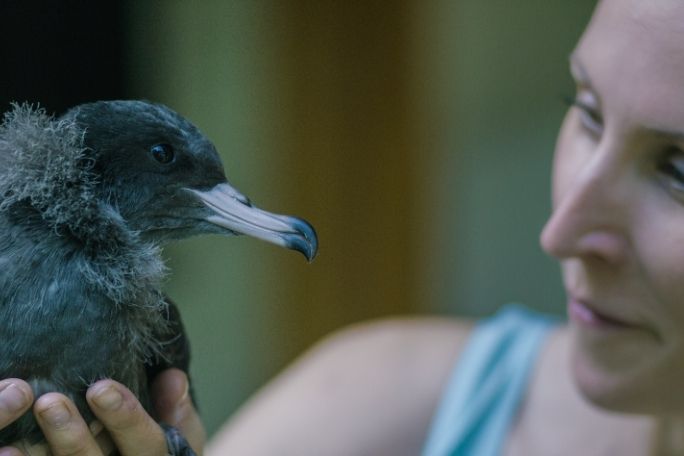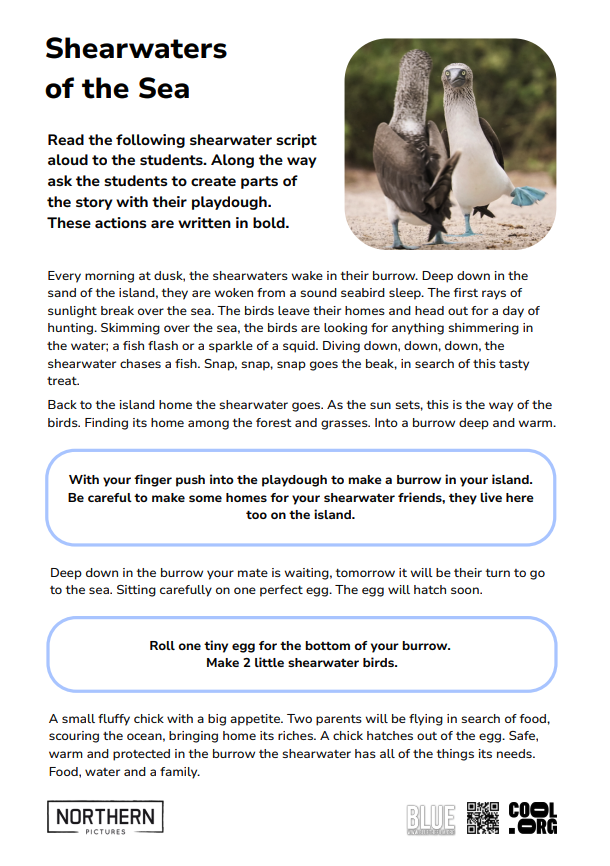Lesson summary
This lesson incorporates clips from Blue The Film as learning inspiration. During this lesson, students discover the biological life of shearwaters. Students begin by exploring the basic needs required for life, and learn what shearwaters eat, where they live, how they raise chicks, and their migration journeys. They then take part in an interactive shearwater sculpting activity, and the artworks they create can be used to help others learn about shearwaters. Finally, the students consider how humans impact the oceans and its living creatures, and they take action by investigating how litter in the school yard might affect the health of the oceans and the creatures that live there.
Learning intentions
Students will..
- learn about the life of shearwaters, finding out what they eat, where they live, why they need our help and how we can help them.
Success criteria
Student can..
- identify how to help the shearwaters by collecting rubbish in the school yard or when visiting the beach
- make a model of a shearwater burrow
- communicate about how plastics are harming the shearwaters.
Lesson guides and printables
Curriculum links
Select your curriculum from the options below.
Lesson details
Skills
This lesson is designed to build students’ competencies in the following skills:
- empathy
- communication
- social skills
Curriculum Mapping
Australian Curriculum content descriptions:
Foundation Science:
- Living things have basic needs, including food and water (ACSSU002)
Year 1 Science:
- Living things live in different places where their needs are met (ACSSU211)
Year 2 Science:
- Living things grow, change and have offspring similar to themselves (ACSSU030)
Syllabus outcomes: STe-8NE, ST1-10LW, ST1-11LW
General capabilities: Critical and Creative Thinking
Cross-curriculum priority: Sustainability
Relevant parts of Foundation Science achievement standards: Students suggest how the environment affects them and other living things.
Relevant parts of Year 1 Science achievement standards: Students describe how different places meet the needs of living things.
Relevant parts of Year 2 Science achievement standards: Students describe changes to living things.
Level of teacher scaffolding: High – oversee activities, lead discussions and to lead play dough sculpt activity.
UN Sustainable Development Goals
- Target 14.1: By 2025, prevent and significantly reduce marine pollution of all kinds, in particular from land-based activities, including marine debris and nutrient pollution.
Resources Required
- Device capable of presenting a website to the class
- Play dough (enough for a medium sized ball for each student), sparkles (e.g. glitter or small pieces of colour paper to represent plastic pieces), large recycled plastic bag
- Shearwaters of the Sea Script
- Flesh-footed Shearwater Picture
Additional Info
Blue is a feature documentary film charting the drastic decline in the health of our oceans. With more than half of all marine life lost and the expansion of the industrialization of the seas, the film sets out the challenges we are facing and the opportunities for positive change.
Blue changes the way we think about our liquid world and inspires the audience to action. Find out how to screen or download the film here. Along with the film is an ambitious global campaign to create advocacy and behaviour change through the #oceanguardian movement. To become an ocean guardian, see the website.
Related Professional Learning
How To Teach Sustainability With Hope
Quick summary: This course is for both primary and secondary teachers of all subjects, but especially for English, Science, Humanities and Geography teachers who are covering climate change and the cross-curriculum priority of sustainability.





Welcome back!
Don't have an account yet?
Log in with:
Create your free Cool.org account.
Many of our resources are free, with an option to upgrade to Cool+ for premium content.
Already have an account?
Sign up with:
By signing up you accept Cool.org's Terms and Conditions(Opens in new tab) and Privacy Policy(Opens in new tab).